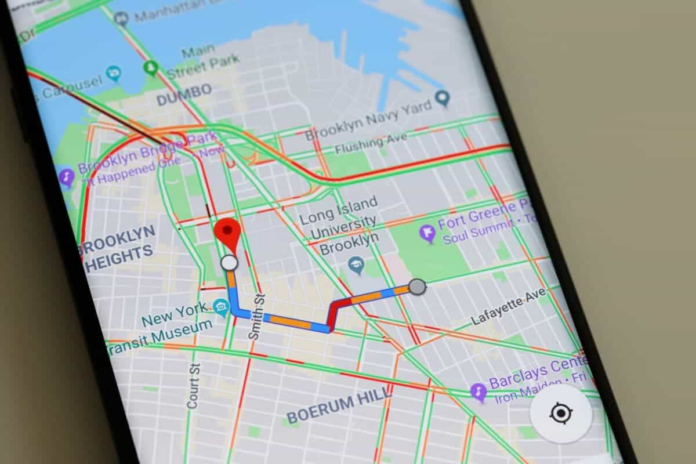In the age of ubiquitous mobile technology, getting lost no longer has to be a worry. For travelers, both domestic and international, having access to reliable offline maps can be a game-changer. Whether navigating bustling city streets or exploring remote countryside, offline maps offer a sense of security and self-reliance, eliminating the dependence on data connectivity and potentially exorbitant roaming charges.
Navigate with Confidence: Exploring the Best Offline Map Apps for Android in 2024
The Android ecosystem boasts a plethora of offline map applications, each catering to specific user needs and preferences. This article delves into six of the most popular and well-established offline map apps, analyzing their functionalities and potential benefits.
1. Google Maps: The Pre-Installed Powerhouse
Google Maps, the de facto mapping solution for many, comes pre-installed on most Android devices. This readily available tool offers exceptional functionality, both online and offline. Users can seamlessly download specific areas of interest for offline exploration. Detailed tutorials are readily available online, guiding users through the simple download process. While offline functionality lacks real-time features like traffic updates, the wealth of pre-downloaded data ensures a comprehensive and reliable navigation experience.
2. Waze: Community-Driven Navigation (Limited Offline Functionality)
Another offering under Google’s umbrella, Waze occupies a unique space in the navigation app arena. While Waze doesn’t directly offer downloadable maps like Google Maps, it possesses a valuable offline mode. By pre-selecting destinations as favorites while connected to the internet, users can still leverage Waze’s strength in navigating to saved locations even without an internet connection. Additionally, offline functionality allows for basic route planning and turn-by-turn directions. This makes Waze a valuable tool for users who prioritize community-driven traffic updates and real-time road condition information during their online journeys.
3. Maps.ME: Open-Source Exploration with a Casual Touch
Maps.ME caters to those who seek a more user-friendly and casual approach to offline navigation. This application utilizes OpenStreetMap (OSM) data, a collaborative, open-source mapping project. While potentially less detailed than commercially-licensed offerings like Google Maps or TomTom, OSM data is generally sufficient for navigating most populated areas and major tourist destinations. Maps.ME offers information on traffic and points of interest, providing a well-rounded offline navigation experience.
4. HERE WeGo: A Global Giant with Rich History
HERE WeGo boasts a long lineage, tracing its roots back to the Nokia Maps application. Currently owned by a consortium of German automotive giants – Audi, BMW, and Daimler – HERE WeGo offers extensive offline functionality. Users can download detailed maps for over 100 countries, ensuring seamless navigation in a vast array of locations. Strengths of HERE WeGo include well-maintained, up-to-date street maps and detailed route planning capabilities, even in offline mode.
5. TomTom AmiGO: Premium Navigation with Brand Recognition
TomTom AmiGO is a great app for finding your way around. It uses TomTom’s famous maps to show you the best routes. You can see live traffic jams and even get warnings about speed cameras.
Want to explore a new country? No problem! TomTom AmiGO has maps for over 150 places. You can save these maps on your phone or use a memory card. This means you can use the app without an internet connection.
There’s a free version of TomTom AmiGO, but if you want extra things like live traffic updates when you’re offline, you can pay a little.
Gizchina News of the week Join GizChina on Telegram
6. OsmAnd: The OpenStreetMap Champion
OsmAnd is a fantastic choice for people who love open-source software and want complete control over their map data. This app uses information from OpenStreetMap to create detailed maps that work even when you’re offline.
OsmAnd is packed with features. You can read Wikipedia articles, find interesting places, check speed limits and traffic (when online), plan walks, bike rides, or drives, and enjoy smooth zooming with vector maps. There are even plugins to personalize the app exactly how you like it.
The basic version is free and offers a ton of great tools. If you want extra features like offline navigation for public transportation, you can upgrade to the paid Pro version. Whether you’re a casual explorer or a serious mapping enthusiast, OsmAnd has something for everyone.
Beyond the Applications: Choosing the Right Tool for the Job
Selecting the ideal offline map application hinges on individual needs and priorities. Travelers venturing into remote areas may prioritize detailed topographical maps, which some applications provide as downloadable add-ons. For those prioritizing real-time traffic information, a subscription to a premium service within an application like TomTom AmiGO may be worthwhile. Ultimately, the best offline map app is the one that empowers users to navigate with confidence and explore the world with minimal reliance on data connectivity.
Tips for Using Offline Maps
Before You Go Plan Ahead: Figure out your path before you leave. Look for places to stop, other ways to go, and spots where you might not have a map.
Figure out your path before you leave. Look for places to stop, other ways to go, and spots where you might not have a map. Get Your Maps Ready: Make sure to download maps before you go. Don’t wait until the last minute.
Make sure to download maps before you go. Don’t wait until the last minute. Pick the Right Map Size: Most apps let you choose how big your map is. Think about where you’re going and how much space you have on your phone.
Most apps let you choose how big your map is. Think about where you’re going and how much space you have on your phone. Have a Backup Plan: Use more than one map app. Some apps are better than others.
Use more than one map app. Some apps are better than others. Save Your Maps: Keep a copy of your maps on something else, like a computer.
Keep a copy of your maps on something else, like a computer. Learn to Read Maps: Even with technology, knowing how to read a map is helpful. On Your Trip Keep Your Phone Charged: Make sure your phone is full or bring a way to charge it. A dead phone is no fun.
Make sure your phone is full or bring a way to charge it. A dead phone is no fun. Save Battery Power: Use the battery-saving mode on your phone.
Use the battery-saving mode on your phone. Close Other Apps: Turn off apps you’re not using to help your phone work better.
Turn off apps you’re not using to help your phone work better. Check for Updates: Some apps let you find new map info even when you’re offline. Do this if you can.
Some apps let you find new map info even when you’re offline. Do this if you can. Trust Yourself: Technology is good, but use your gut feeling too. If something seems wrong, it probably is.
Technology is good, but use your gut feeling too. If something seems wrong, it probably is. Use All the Tools: Many map apps have other cool things like places to see and ways to find things. Learn how to use them. Other Helpful Tips Use Wi-Fi: When you can, use free Wi-Fi to get new maps and information.
When you can, use free Wi-Fi to get new maps and information. Special Map Apps: There are apps made just for using maps without internet.
There are apps made just for using maps without internet. Paper Maps: Bring a paper map as a backup.
Bring a paper map as a backup. Ask People: Talk to people where you are. They can help you find your way. Use these tips to have a great time exploring with offline maps! Conclusion Offline maps are always getting better. New things are added all the time. It’s important to use the newest version of your map app to get the best maps and tools. Some apps, like OsmAnd, let people help make the maps better. This makes the maps more correct and reliable. If you pick the right map app for your trips, you can feel good about finding your way, even when you’re far from home or don’t have internet.
Disclaimer: We may be compensated by some of the companies whose products we talk about, but our articles and reviews are always our honest opinions. For more details, you can check out our editorial guidelines and learn about how we use affiliate links.
Travel Smart: Top 7 Offline Map Apps to Stay on Track Anywhere
Recent Comments
on After UFC Fallout, Conor McGregor Offers a Valuable Piece of Advice to Free Agent Francis Ngannou
on 2024 Super Bowl: CBS Sports Network and CBS Sports HQ to combine for 115 hours of weeklong coverage
on ‘Best Intention’: Chris Kirk Has Absolute Trust in Jay Monahan and PGA Tour’s Widely Debated Model
on 2023 NFL All-Rookie Team: CBS Sports draft expert, former GM unveil league’s best first-year players
on “Completely Knocked Me Out”: Rob Lowe Recalls Boxing Match With Tom Cruise On 1983 Brat Pack Classic
on CONCEPT ART: New Details Revealed for Disney Cruise Line Lookout Cay at Lighthouse Point Destination
on “Completely Knocked Me Out”: Rob Lowe Recalls Boxing Match With Tom Cruise On 1983 Brat Pack Classic
on CBS Sports announces Matt Ryan will join NFL studio show. Longtime analysts Simms and Esiason depart
on Carlos Sainz’s Soccer Fanboy Emerges as Spaniard Shares Defining Moment With This Real Madrid Legend
on Biden: ‘At this point I’m not’ planning to visit East Palestine, Ohio, after toxic train derailment
on ‘Best Intention’: Chris Kirk Has Absolute Trust in Jay Monahan and PGA Tour’s Widely Debated Model
on Ahead of big sports weekend, dispute with Disney leaves millions of cable subscribers in the dark
on A heavy wave of Russian missile attacks pounds areas across Ukraine, killing at least 4 civilians
on 2024 Super Bowl: CBS Sports Network and CBS Sports HQ to combine for 115 hours of weeklong coverage
on 2023 NFL All-Rookie Team: CBS Sports draft expert, former GM unveil league’s best first-year players
on Army vs. Coastal Carolina live stream, how to watch online, CBS Sports Network channel finder, odds
on AL Rookie of the Year Julio Rodriguez Spreads Joy and Sportsmanship to the Youth of Loma de Cabrera
on After UFC Fallout, Conor McGregor Offers a Valuable Piece of Advice to Free Agent Francis Ngannou
on Dubai International Airport sees 41.6 million passengers in first half of year, more than in 2019
on Devout athletes find strength in their faith. But practicing it and elite sports can pose hurdles
on Despite strong Lunar New Year holiday data, consumer spending in China isn’t roaring back just yet
on Dave Portnoy: Taylor Swift’s security should ‘drag Kim Kardashian to jail’ if she attends Eras Tour
on CONCEPT ART: New Details Revealed for Disney Cruise Line Lookout Cay at Lighthouse Point Destination
on “Completely Knocked Me Out”: Rob Lowe Recalls Boxing Match With Tom Cruise On 1983 Brat Pack Classic
on CBS Sports, Serie A announce new TV rights deal; Paramount+ to air over 400 Italian soccer matches
on Cam Newton’s Violent Public Incident Draws Hilarious Reaction From 3x All-Star: “Where Do I Sign Up
on Boston College vs. Army live stream, how to watch online, CBS Sports Network channel finder, odds
on Angel Reese Launches Foundation Dedicated To Empowering Women Through Sports & Financial Literacy
on A weaker dollar, skyrocketing prices and ‘record’ visitor numbers: Good luck in Europe this summer




